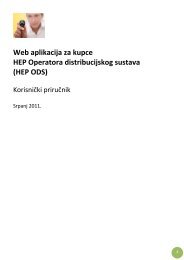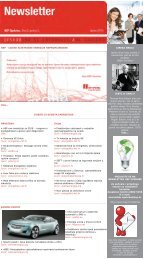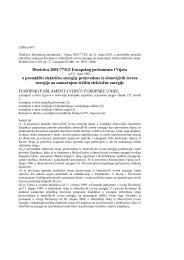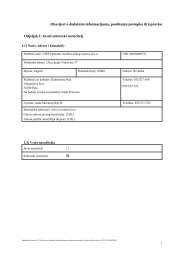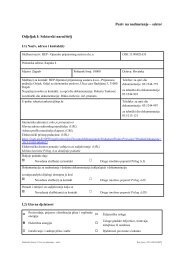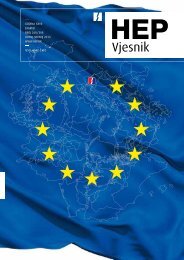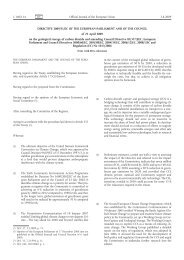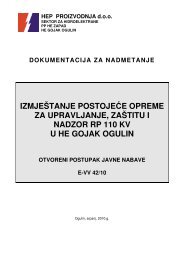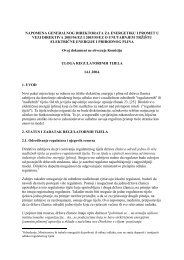Untitled
Untitled
Untitled
You also want an ePaper? Increase the reach of your titles
YUMPU automatically turns print PDFs into web optimized ePapers that Google loves.
zakonskih akata, provede sve nuæne analize kojeu sluËaju utvrappleivanja metoda za izraËun cijenausluga ponekad (po iskustvima drugih regulatornihtijela) traju i po 18 mjeseci [6].Osim stope povrata, kod CAPEX -a, dilemu predstavljatumaËenje i drugih pojmova koje prepoznajetarifni sustav, a isti nisu u dovoljnoj mjeripojaπnjeni, npr. vrijednost novih investicija koje susufinancirane. Pretpostavlja se da ih sufinancirakupac. Troπak investicije koji je financirao kupacne bi trebao uÊi u regulatornu osnovicu sredstavaniti biti priznat kroz troπak amortizacije energetskogsubjekta, buduÊi da bi na taj naËin kupacplaÊao investiciju dva puta ∑ kroz troπak investicijei kroz tarifu. Upitno je na koji naËin Êe HERApristupiti rjeπavanju problema investicija koje sufinancirakupac.Navedeni primjeri pitanja na koje HERA moraodgovoriti prilikom davanja miπljenja na prijedlogiznosa tarifa i provoappleenja regulatorne politikesamo su ilustrativni. Primjena ekonomske regulacijeseæe puno dublje i kompleksnija je od navedenihprimjera te zahtijeva detaljne elaboracijei analize. No, i argumentirani stavovi koje HERAtreba zauzeti prilikom rjeπavanja navedenih dilemaiz opisanog primjera mogu znaËajno utjecatina razinu tarifnih stavki pojedinih djelatnosti te naraspodjelu troπkova i prihoda izmeappleu djelatnosti.Furthermore, transparent division also has an impacton CAPEX in all activities. For each activity, theCERA would have to determine the justified levelof the initial regulatory asset base, the depreciationpolicy and the assets that would be allocated to theregulatory asset base during the regulatory period,to which the rate of return on capital would be applied.The rate that is applied to the mean value ofthe regulatory asset base is determined by the CERAat the proposal of the energy entity. A problem thatoccurs here is the determination of the justified rateof return, since this concerns activities that differ innature ∑ monopolistic and market, from which thereare different degrees of risks in operations as well asdifferent conditions of financing. From the descriptionof the methods stated in the tariff systems, it isnot clear which rate will be applied and whether therates will differ according to activities, although theyconcern the same vertically organized enterprise inthe HEP Group. Determination of the rate of returnrequires detailed analysis. In order for the CERA’swork to obtain credibility and professionalism, priorto adopting decisions and regulations the CERAmust first perform all the necessary analyses in atimely manner, which in the case of the determinationof the methods for the calculation of the pricesfor services sometimes (according to the experiencesof other regulatory bodies) requires as long as 18months [6].In addition to the rate of return, regarding CAPEXthere is a dilemma posed by the interpretation ofother concepts that the tariff system recognizes,which are not explained to a sufficient extent,such as the value of new investments that are cofinanced.It is assumed that they are co-financedby the customer. An investment expenditure that acustomer has financed should not enter the regulatoryasset base or be recognized as a depreciationexpenditure of the energy entity. Otherwise, the customerwould have to pay for the investment twice∑ through the investment expenditure and throughthe tariff. Therefore, it is a question how the CERAwill approach the solution of the problem of investmentsthat are co-financed by the customer.The cited examples of questions to which the CERAmust respond when issuing an opinion on the proposedamounts of tariffs and the implementation ofregulatory policies are merely illustrative. The applicationof economic regulations ranges far deeper, ismuch more complex than the examples presentedand requires more detailed elaboration and analysis.However, the argued positions that the CERAshould assume when resolving the cited dilemmasfrom the example described could significantly affectthe level of the tariff items for individual activitiesand the allocation of expenditures and revenuesamong the activities.579Štritof,I., KleËina, F., Regulatorna politika i njen utjecaj ..., Energija, god. 56(2007), br. 5., str. 554-583Štritof, I., KleËina, F., Regulatory Polica and Its Impact ..., Energija, vol. 56(2007), No. 5, pp. 554-583



